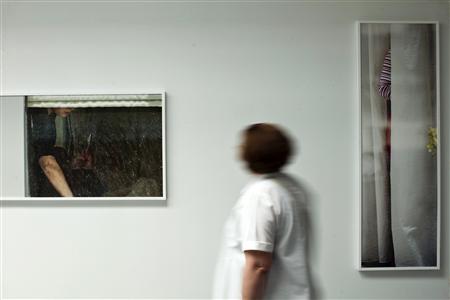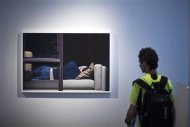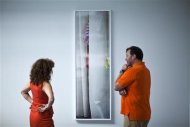Sunday, June 9, 2013
Since when is secretly photographing people in their own homes a First Amendment right?
(Reuters) - Space-starved New Yorkers might know better than to expect privacy in their glass-and-steel residential boxes. Yet, even by Manhattan standards, an exhibit by a photographer who used a zoom lens to secretly photograph his neighbors napping and eating has caused a citywide stir - and two legal actions, so far.
Photographer Arne Svenson says he 'started the project after inheriting a telephoto lens from a friend. He began taking pictures of the apartments opposite his own Tribeca home in 2012.
Those images are now on show — and for sale at prices of up to $7,500 per photo — at a Chelsea gallery, where they prompted a legal complaint from Martha and Matthew Foster, parents of the young children featured in two of his photographs.
The Fosters said the pictures raised concerns about the safety of their children as well as fears that they "must keep their shades drawn at all hours of the day in order to avoid telephoto photography by a neighbor."
For the rest of New York, the controversy over the exhibition has triggered a conversation about First Amendment rights and just how much privacy city dwellers can expect.
FIGHTING BACK
In the latest development, Svenson is fighting back. On Wednesday, his attorney filed a motion calling for the New York county court to throw out the Fosters' complaint. The motion argues that the pictures are not illegal and are protected under an artist's freedom of expression under First Amendment rights. Svenson is no longer commenting on the controversy, but says in his exhibition notes: "For my subjects, there is no question of privacy… The neighbors don't know they are being photographed; I carefully shoot from the shadows of my home into theirs."
The photographs themselves are both abstract and specific, capturing mundane but intimate moments of domestic modern life. All are carefully framed to avoid revealing the full faces of their subjects. A woman in a raincoat stands by the window, her face obscured by a twisted gold curtain. A man in T-shirt and jeans dozes on a sofa. An expectant mother is pictured in profile. The lower halves of a couple in bath robes are caught breakfasting, their feet touching under the table. Another woman is crouched near the window, scrubbing the floor or picking something off the ground.
The Fosters' complaint details the couple's distress about two photos that feature their children. One image shows Martha Foster holding her 2-year-old son, with her 4-year-old daughter standing beside her. The girl is in a swim suit; the boy is wearing a diaper. The document alleges that the minors' faces are "clearly recognizable," which could endanger their safety by attracting the attention of "undesirable and potentially dangerous people."
The plaintiffs say they are "frightened and angered" by the "utter disregard for their privacy and the privacy of their children" and the "seclusion and solitude of their homes." The complaint adds that Svenson's conduct is "so out of keeping with the standards of morality in the community as to evince an intentional or reckless disregard of its likelihood to cause severe emotional distress to the Fosters."
Although Svenson removed the pictures from the exhibition when contacted by an attorney, the Fosters still want to remove all remaining pictures from the photographer's possession, a permanent injunction against further photographic intrusions, plus damages and costs.
Svenson's legal motion of June 5 asserts that neither his conduct nor photographs violate any New York laws. The document adds that as the images "were taken through windows that are fully exposed to the street, they cannot support a claim for intentional infliction of severe emotional distress."
With regard to the photos that feature the Fosters, the motion states that the faces of the parents are not revealed, the children are obscured and the subjects are in plain view. "Both photographs capture children at play and the innocence of childhood, nothing more revealing than you might see in a neighborhood park," the document says. It asserts that Svenson's images are protected by First Amendment rights and that the "Plaintiffs should not be permitted to use the Court to attempt to restrict artistic expressions that they disagree with."
Julie Saul, the gallery owner and director, told Reuters that the reaction to the exhibition was a "huge surprise" and a "tempest in a teapot." "It really never occurred to me that there would any of the controversial issues surrounding the work because historically there have been lots and lots of photographers who have photographed on the street, through windows, there's a whole history of it," she said.
Mickey Osterreicher, an attorney and general counsel for the National Press Photographers Association, described the case as "very interesting." "Most people have this sense in New York because everybody lives so close together, because the line sights are such, that you can very easily look into your neighbors' apartment and they can look into yours, but I think the court may parse this out as looking is one thing and photographing is another," he told Reuters.
Osterreicher is concerned that a ruling in this case could "create more pushback by people who are looking to create an expectation of privacy even when you're out in public." He thinks this could lead to First Amendment protections being "chipped away." Osterreicher believes that this case has been a negative one for the image of photography and First Amendment rights due to the "bad taste" that has been left with the public. The attorney believes that the case against Svenson may "turn more on the facts of the case than on the actual law."
While the case remains in the hands of the New York State Justice system, the issues raised by Svenson's photographs are as ethical as they are legal. Saul said: "If it's an ethical issue I think it's about the individual, and the way that Arne has handled this work is incredibly respectful and ethical."
Clearly, others disagree.
Labels:
lost rights,
Lost Values,
the arts
Subscribe to:
Post Comments (Atom)







No comments:
Post a Comment